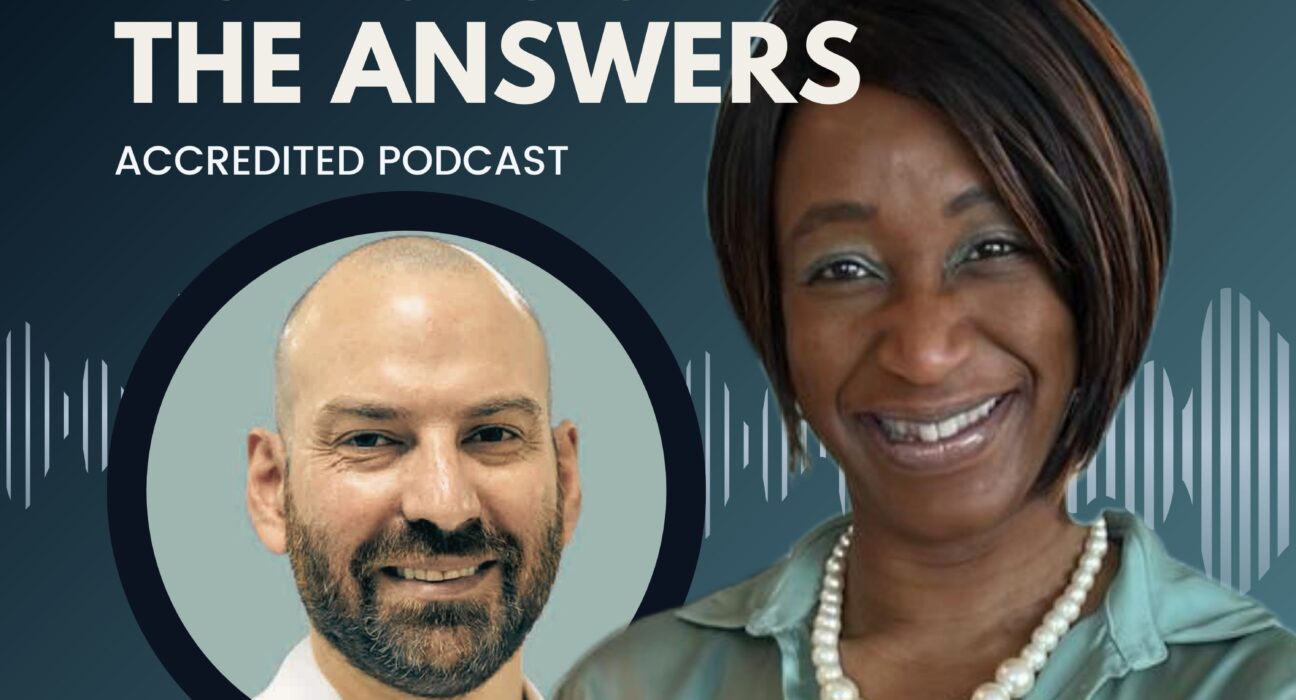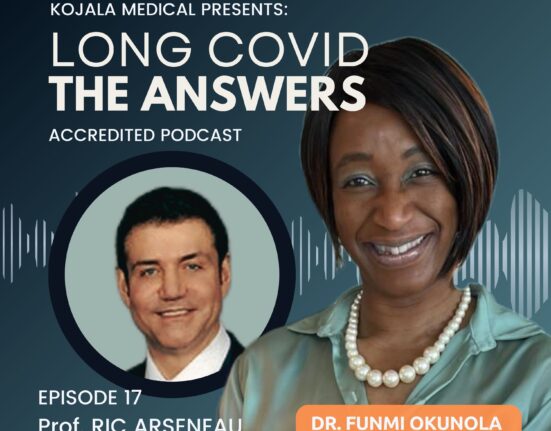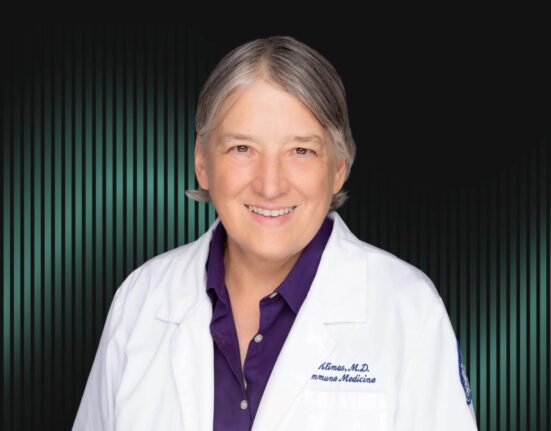
Professor David Putrino is a physiotherapist with a PhD in Neuroscience. He is currently the Director of Rehabilitation Innovation for the Mount Sinai Health System, and a Professor in the Department of Rehabilitation and Human Performance at the Icahn School of Medicine at Mount Sinai. Professor Putrino recently opened the Mount Sinai Cohen Center for Recovery from Complex Chronic Illness in New York also known as (CoRE) and serves as CoRE’s Family Director and is also a member of PolyBio’s Long COVID Research Consortium. Today we talk about the pathophysiology of Long COVID in the context of describing research into targeted treatments for the disease.
Guest – Professor David Putrino
Note: The podcast has no bias. All conflicts of interest are highlighted with individual guests.
Healthcare Professionals | Earn 0.5 Certified Mainpro+® Credits! Please register/login to claim your CPD/ CEU credits.
Podcast Overview:
Dr. David Putrino highlights the complexity of Long COVID, emphasizing hormonal and neurological impacts. Research shows hormonal disruptions, including low cortisol, are common in some patients, influencing symptoms like fatigue. Gender-specific patterns reveal women often have low testosterone, while men show reduced estradiol, correlating with differing symptoms. Neurologically, Long COVID causes neuroinflammation and vagus nerve dysfunction, contributing to issues like cognitive impairment and POTS. Emerging treatments include medications, innovative devices like vagus nerve stimulators and magnetic resonance therapy, and procedures such as stellate ganglion blocks. These interventions, supported by ongoing research, offer hope for tailored therapies to address Long COVID’s diverse effects.
- Hormonal Changes:
- Long COVID often triggers hormonal disruptions, including low morning cortisol in some patients.
- Cortisol, vital for waking up and managing stress, is significantly reduced in affected individuals.
- Women with Long COVID frequently exhibit low testosterone, worsening symptoms like fatigue and hair loss.
- Men with Long COVID often have low estradiol, linked to symptoms like sexual dysfunction.
- Hormonal dysregulation varies between patients, with research showing correlations between hormone levels and symptom severity.
- Neurological Changes:
- Neuroinflammation is a key driver of cognitive impairment in Long COVID, as shown in both human and animal studies.
- Long COVID can disrupt the vagus nerve, affecting functions like blood pressure, heart rate, and breathing, contributing to symptoms like POTS (Postural Orthostatic Tachycardia Syndrome).
- Chemokine activity in Long COVID is associated with neurological injury and cognitive decline.
- Emerging Treatments:
- Medications such as beta blockers and ivabradine are used to manage POTS symptoms.
- Devices like vagus nerve stimulators and magnetic resonance therapy show promise in reducing neuroinflammation.
- Procedures like stellate ganglion blocks target autonomic nervous system imbalances.
- Continued research and clinical trials are crucial for personalized and effective therapies.
DISCLAIMER: The information in this podcast is provided for informational purposes only. You should not use any information discussed in this podcast and related materials to make medical or healthcare related decisions. Always consult a your physician or other qualified health care provider with regards to diagnosing managing your medical condition. Any medications or treatments, including any discussed in this podcast, should be initiated and managed by a qualified health care professional.
Podcast Transcript:
Healthcare Professionals: Please note to claim Certified CPD / CEU credits toward your medical license (Canada & reciprocal CPD/CEU Worldwide), you will need to register or log in.
Episode 27 – Long COVID Research & Potential Treatments Part 1 ft Prof David Putrino PhD
[00:00:00] Funmi Okunola: The information in this podcast is provided for informational purposes only. You should not use any information discussed in this podcast and related materials to make medical or healthcare related decisions. Always consult your physician or other qualified healthcare providers with regards to diagnosing and managing your medical condition. Any medications or treatments, including any discussed in this podcast
Funmi Okunola: [00:00:00] Welcome to Long COVID – The Answers. Today’s Episode is entitled “Long COVID Research and Potential Treatments”. This is the first of a two-part Episode about the subject matter. I’d like to introduce Professor David Putrino. David is a physiotherapist with a PhD in neuroscience. He worked as a clinician in Australia before moving to the United States to study Computational Neuroscience at Harvard Medical School, MIT and New York University.
He has served as a faculty member at Weill Cornell Medicine and Berk Medical Research Institute. He is currently the Director of Rehabilitation Innovation for the Mount Sinai Health System and a professor in the Department of Rehabilitation and Human Performance at the Icahn School of Medicine at Mount Sinai.
Professor Putrino recently opened the Mount Sinai Cohen Center for Recovery from Complex Chronic Illness in New York, also known as CoRE, with Dr. Amy Proal, President of PolyBio [00:01:00] Research Foundation, a scientist who we interviewed back in Episodes 12 and 13. Professor Putrino serves as CoRE’s Family Director and is also a member of PolyBio’s Long COVID Research Consortium.
Welcome, David.
David Putrino: Thank you so much for having me. It’s great to be here.
Funmi Okunola: Thank you. David, do you have any conflicts of interest to declare?
David Putrino: No, no conflicts of interest to declare.
Funmi Okunola: Great. I invited Professor Putrino to be interviewed today not only because of his vast experience in rehabilitating Long Haulers since the onset of the pandemic, but also because of his groundbreaking research.
His work is crucial in advancing our understanding of the disease process behind Complex Chronic Conditions like Long COVID and gives real hope for the development of direct treatments for this illness.
David let’s start with Complex Chronic Disease, the pathophysiology of Long COVID, and then discuss the targeted treatments that [00:02:00] you believe will work for this illness.
Can you explain what Post Viral Illness or Post Acute Infection Syndrome, otherwise known as Complex Chronic Disease, is with examples?
David Putrino: Yes, absolutely. We think about Post Acute Infection Syndromes as a family of different conditions that really occur when someone is infected with a pathogen.
Now, this can be a virus. This can be a bacterium. This can be a mold or a parasite of some sort. Any sort of pathogen infects the individual, and unlike the majority of the population who are able to clear the pathogen and return back to their baseline health for whatever reason, an individual with a Post Acute Infection Syndrome is unable to do so, and their health baseline shifts, and they enter into this disease [00:03:00] state that we identify as a Post Acute Infection Syndrome.
I think it’s also important to acknowledge the fact that sometimes Post Acute Infection Syndrome, such as Myalgic Encephalomyelitis or Chronic Fatigue Syndrome (which is shortened to ME/CFS) can have a non-infectious trigger. This does not eliminate the possibility that we are still dealing with a Post Acute Infection Syndrome.
Sometimes the trigger that leads the person to become sick isn’t necessarily an infectious trigger, and this is what we sometimes refer to as multiple hits – meaning that you can maybe get sick with the flu virus or get sick with a bacterial infection early in the year. You think it’s gone away because it’s sort of smoldering beneath the surface, and then something else causes an immune challenge such as a high [00:04:00] stress event or a car accident or an injury, and that leads you into this Post Acute Infection Syndrome disease state – so, common Post Acute Infection Syndromes.
The most common one that we talk about a lot is, of course, Long COVID. We also talk about chronic tic and vector born illness. These are people who are chronically ill after being infected with bacteria that are carried by tics and other vectors, such as spiders and mosquitoes and other terrible things that bite you in the night.
Other viruses as well can have Post Acute Infection Syndromes associated with them. You will sometimes hear about things like Post Zika Syndrome and Post Ebola Syndrome. There are many of these Post Acute Infection Syndromes that are out there.
Funmi Okunola: Thank you. That’s an excellent answer.
So, David we’ve already explored the pathophysiology of Long COVID in Episode 2 with Professor Danny Altman and Post Viral Illness in Episodes 12 to 13 with Dr. Amy [00:05:00] Proal. The following questions focus on you outlining the disease-causing processes of Long COVID as identified through evidence-based research by you and your scientific colleagues, as well as the treatments you believe should be further investigated to address these issues.
David, can you please remind us how viral persistence causes Long COVID symptoms, and what you think the treatment could be that could combat this?
David Putrino: Yes, I think that’s a great question, and I think that when we’re thinking about Post Acute Infection Syndromes the clue is in the name, right?
We don’t often refer to things as Post Viral Syndromes because we can’t quite rule out one of the simplest explanations for why people are still sick, which is that the virus is still there. So that’s where Post Acute Infection Syndrome comes from. We know it’s not an acute infectious process anymore.
It may be a post acute infectious process, meaning that the body has [00:06:00] never fully cleared the virus. So, in the case of Long COVID there has been ample evidence, and in fact many of my colleagues who are part of the Long COVID Research Consortium led by Amy Proal were co-authors in a review document that was published.
The lead author was Dr. Amy Proal where we showed all of the studies that have recently been published in the last twelve to eighteen months all showing direct evidence for the fact that people with Long COVID seemed to have persistent virus somewhere in their body.
Now to be very clear, in humans there’s no clear evidence for whole replicating virus in the body. The reason that there is no clear evidence for whole replicating virus in the body is that largely the studies that have looked for viral persistence have consisted of studies that look for the pathogen in the [00:07:00] blood, and studies that look for the pathogen in biomarkers that are associated with looking in places where the virus isn’t necessarily going to be located.
The more we start to get into tissue sampling and the more we start taking biopsies and really looking, that’s when we start to see partial and whole virus being discovered. That’s when we really start to see evidence of clear viral persistence. Like I said, there have been many, many studies at this point showing that this is a virus that is capable of persisting in the body.
The next generation of research studies that we need to understand is when the virus persists and when pieces of the virus persist. So viral antigens, things like the spike protein that are circulating around the body, what damage is that doing to us? We need to better understand this in a very detailed way. What’s going on there? But regardless of the [00:08:00] absolute minutia of what a persistent antigen is doing in the body or what a viral persistence is doing to the body, we should also be working in parallel to deploy and test interventions that may have a role in eradicating the virus from the body.
So, to that end there are many broad-spectrum antiviral medications that are worthwhile in trialing. There’s evidence to suggest that repurposed HIV medications such as Truvada or Maraviroc may have a role in either eliminating persistent virus or blocking persistent virus from infecting cells and in tissue.
There are a number of monoclonal antibodies that were created to eradicate SARS-CoV-2, and as long as we can match the monoclonal with the time at which the individual with Long COVID [00:09:00] got sick, there is a lot of really good research to suggest that monoclonals may be a viable clinical trial target for people with Long COVID.
There are mainstream SARS-CoV-2 antivirals such as Paxlovid that have been trialed, and the early results have not been as effective as we might have hoped, but the takeaway from that which I think is really important is that Paxlovid is first and foremost a protease inhibitor.
It stops the virus from replicating, but it doesn’t necessarily eradicate the virus. Secondly, it is an antiviral that doesn’t have good tissue penetration. So, unless you have a sort of a heaving infection, an acute infection, which is what Paxlovid was developed for, we wouldn’t expect it to be so effective at addressing persistent pathogens that hide in tissue as opposed to circulating in the bloodstream and elsewhere. There is a lot of [00:10:00] space for testing out a lot of target drugs to address viral persistence. Also, I think there really is an important role for multi-drug therapies.
So not just testing out one antiviral or one monoclonal but testing them in combination because what we’re proving over and over again is that in the subset of patients where pathogens persist, often it’s very, very hard to clear those pathogens, and so it may not be a single drug problem. It may be a multi-drug problem, although this hasn’t yet been done in a large scale in Long COVID. We can look to the work of people like Monica Embers who has done incredible work in primate models, non-human primate models, studying chronic Lyme Disease and the persistence of Borrelia, showing that you can often need multiple antibiotics to fully eradicate Borrelia from a non-human primate, as opposed to the simple course of [00:11:00] doxycycline that we’re told will clear Borrelia in the majority of cases. I would say that multi-drug approaches should be considered as well.
Funmi Okunola: Excellent. What is immune dysregulation and what potential drug targets could help address it?
David Putrino: Immune dysregulation is a broad reaching term that can probably mean many different things. But one of the things that we published on in late 2023 with our amazing colleague Akiko Iwasaki from Yale University was that when we compared deep immune profiling results from healthy controls to people who had been diagnosed with Long COVID, what we saw was evidence of what’s known as T-cell exhaustion, meaning that T-cell activation had been prolonged. T-cells are these immune cells that we often use to go out and fight off pathogens, and what we were seeing in [00:12:00] folks with Long COVID was that there was evidence that these T-cells have been activated for a very long time and that they were starting to lose their efficacy in fighting off invaders.
Now, that can lead to two things. If you have a persistent pathogen – so, if Long COVID is indeed a result of SARS-CoV-2 persisting in your body, that’s going to lead to SARS-CoV-2 starting to mount a counteroffensive and perhaps causing more symptoms. But what we were also seeing was clear evidence of reactivation of latent viruses, herpes viruses, EBV, CMV – this was much more likely to be present in the immune profiling of people with Long COVID compared to healthy controls.
Immune dysregulation can lead to this cascade of other problems. But it all stems from this idea that for some [00:13:00] reason, whether it be persistent pathogens or whether it be just this prolonged immune response from autoimmunity, your immune system is getting tired, and you’re not fending off pathogens the way that you should.
So, you’re either experiencing reactivation of old pathogens or you’re experiencing increased susceptibility to new pathogens. Either way you’re starting to enter into this state where you’re constantly very, very stressed – sick, and as we explore interventions that may be helpful here one of the ones that we’re most excited about is low dose rapamycin.
Rapamycin is an mTOR inhibitor. It’s this particular drug that works along the mTOR pathway which has a lot of immune and metabolic sequelae. If you read about rapamycin at high dose, you’ll learn that it’s an immunosuppressive drug. However, at much lower doses, fractional [00:14:00] doses compared to what it’s actually FDA approved for, there’s been some really fascinating work that has been completed both in animals and humans showing that rapamycin can improve interferon signaling. It can decrease T-cell exhaustion, and it can improve natural killer cell functioning as well. So, we do have this theory that hopefully we will be testing in early 2025.
We’ve just received an IND exemption from the FDA to begin testing, trialing rapamycin, and we’re just waiting on our ethics board to approve the protocol, which we hope will happen in early 2025. We are hoping that low-dose rapamycin (which at a low dose is a very safe drug with very few adverse events) can be helpful in a subset of people with Long COVID who may be experiencing this immune dysregulation flavor that includes T-cell exhaustion.
Funmi Okunola: That’s fantastic. So, I [00:15:00] guess to explain to our non-medical audience, this drug is in effect reducing some of the inflammatory processes and boosting the T-cells which are the infection-fighting cells to get rid of what latent virus that might be there or reactivated virus. Is that the way you’re looking at it?
David Putrino: Absolutely. Yes.
Funmi Okunola: Great. Please talk about endothelial dysfunction and coagulation issues, and again what you think could be done to mitigate this.
David Putrino: Yes. Early in the pandemic we started hearing about a researcher in South Africa who was doing some really amazing work, and that turned out to be a Dr Resia Pretorius, who had been studying this sort of odd phenomenon of these fibrin amyloid clumps that would emerge in the bloodstream of people with various different pathologies. She’s been researching this for years and when COVID emerged [00:16:00] she started looking for these fiber and amyloid bundles in people with COVID, then subsequently at people with Long COVID, and her research was very elegantly performed and really beautifully done. Time after time it was showing that folks with Long COVID were experiencing a proliferation of these little clumps of fibrin.
Fibrin is a protein that the body produces as a byproduct of inflammation, and it’s a very – I don’t want to simplify it too much, but we could think of it as a very sticky protein. So, things attach to it, and then as things attached to it, if you have a lot of fibrin laying down in the bloodstream, you can start to get these little clumps which were colloquially named ‘micro clots’ that aren’t big enough to block a big vessel but certainly are big enough to block micro vessels and micro vasculature, and potentially cause a [00:17:00] lot of the symptoms that people experience when they’re told everything’s fine – you’re testing normal, your blood oxygenation is normal, and yet if this microvascular vasculature is getting compromised, many of the symptoms that people are reporting with on COVID could certainly be explained by that.
We had the pleasure of meeting Dr. Pretorius when she came out to New York from South Africa to teach us all how to look at the micro clots. As we started to learn the methodology, we started to see that not only did people with Long COVID have these fiber and amyloid micro clots circulating in their system but we were also seeing evidence that their platelets (which are another sort of blood product that circulate in the body) were hyper activated – meaning we can think of that as their platelets being inflamed. When you have that much debris, that much junk circulating in your vasculature as well as [00:18:00] these platelets, which are these tiny little particles that are highly inflamed also circulating around in your system, you might imagine that it creates this sort of cyclical issue with the walls of your blood vessel also starting to become inflamed, also starting to get damaged by the junk that is circulating around. As we also know from Professor David Waltz work out of Harvard, roughly 40% of people with Long COVID have spike protein circulating in their plasma.
Spike, the spike protein we know binds with ACE-2 receptors. Our endothelium – the inner layer of our blood vessel – is full of ACE-2 receptors. So, what we can imagine happening is you’ve got these spike proteins circulating around. They’re binding with ACE receptors causing inflammation. Then you’ve got micro clots circulating – you’ve got hyper-activated platelets, and suddenly you have this terribly unhappy cycle of the [00:19:00] endothelium being inflamed from circulating spike the inflammation being even worse, propagated by these micro clots and hyper activated platelets, and then suddenly you’ve got systemic inflammation throughout the whole body within your blood vessels. This is as you might imagine, something that is an unpleasant situation that we definitely want to try to mitigate if we can. Our team seems to think that one of the safest first-pass interventions to trial just to understand how the body is responding to interventions of this nature would be trialing out, what are called proteolytic enzymes such as nattokinase and lumbrokinase.
These are two enzymes that actually break down fibrin, that sticky protein that seems to cluster everything together, and subsequently if they can break down the fibrin then they can break up the micro clots, and if we can break [00:20:00] up the micro clots, hopefully we can stop any sort of micro vascular damage occurring which is what we fear when these things are running unchecked.
We’ve already begun that clinical trial, and we have our first sort of half dozen people enrolled into that, and we hope to be completing that clinical trial in 2025. In every patient who goes through that protocol, we’re going to be looking to see whether their coagulation profile improves over time as a result of taking these proteolytic enzymes.
Funmi Okunola: Oh, that’s fantastic, David. That was an excellent explanation. Textbook actually. Could you briefly discuss the hormonal changes associated with Long COVID, and what can be done to treat them?
David Putrino: Yes, we’ve started to see that Long COVID definitely triggers hormonal changes in individuals.
In our first paper with Akiko Iwasaki’s team, we showed [00:21:00] that folks with Long COVID were much more likely to experience low morning cortisol rather than healthy co, and I want to caveat – and this is probably something that we should just constantly say over and over again. People can get sick as a result of many different things when they get a diagnosis of Long COVID. Not everyone is going to have the hormonal changes. Not everyone is going to have immune dysregulation or viral persistence or micro clots, and similarly, not everybody has low morning cortisol, but it was a very powerful predictor of identifying differences between people with Long COVID and healthy controls.
Cortisol is this very interesting hormone. We often think about it as a stress hormone, but it does so much more than just manage our stress levels or mediate inflammatory responses. It also does things like wake us up in the morning. Cortisol is actually what gives your [00:22:00] brain the trigger to wake up from sleep.
So, depending on when you wake up, a few hours before you wake up, your cortisol levels will be very low because you’re fast asleep, and they’ll slowly start to rise. When they hit a critical period, that’s when your brain says, “Oh, cortisol is rising. Let’s open the eyes and get to work.” When we saw that people with Long COVID had extremely low morning cortisol that was an interesting clue for us. It told us that maybe something hormonal was going on.
Julio Silva and Takahiro from Akiko’s lab really did some amazing work where they looked into other hormones in both male and female people with Long COVID, and one of the reasons that we were interested in separating out the sexes was because we were hearing all about how people with Long COVID were, of course, more likely to be female.
What was that about? And why might that [00:23:00] be? Julio and Takahiro’s work really showed us two things that were very, very interesting. Firstly, the symptoms being experienced by women and men were slightly different. So certain symptoms, some of the common symptoms, were very much the same of course, but certain symptoms were more likely to be female than male and vice versa.
Things like sexual dysfunction were more likely to be reported by men with Long COVID, versus symptoms like hair loss were much more likely to be reported by women with Long COVID. Once again, this doesn’t mean that a man can’t have hair loss, and a woman can’t have sexual dysfunction. It just means that there was an increased likelihood, and then as we dug a little deeper, we started to see very powerful correlations between hormone expression and these symptoms.
Women with Long COVID were much more likely to have extremely lower testosterone levels than [00:24:00] men with Long COVID. In fact, we even saw a correlation where the lower the testosterone levels went the more severe those female-associated symptoms became. Similarly, men with Long COVID were much more likely to have low estradiol levels, so a derivative of estrogen, and the lower their estradiol levels went, the worse their male-associated symptoms would become.
This work is only in pre-print right now. It’s still under peer review, but it can be accessed online where you can just view the data. The data themselves are very striking. Since we preprinted the work, there have now been a couple of other publications that have emerged showing similar trends, which really do tell us that hormonal dysregulation is occurring in Long COVID.
Funmi Okunola: Gosh, that is absolutely fascinating. The research that you’re doing is just going to be pioneering in helping us to understand how our bodies work as a whole. Anyway, [00:25:00] never mind, understanding the pathophysiology of Long COVID, just remarkable.
What type of damage does Long COVID cause to the central nervous system, and what potential interventions could help address it?
David Putrino: Yes, so the central nervous system can be affected by Long COVID in so many different ways. We saw some phenomenal work published by Mike Van Elzak at Harvard showing very clear signs of neuroinflammation driving some of the cognitive impairment in people with Long COVID.
We clearly know that there is inflammation occurring, and myself, Akiko Iwasaki and Michelle Monje from Stanford University also published some work in a cross-species model both in mice and in humans, showing that specific chemokines, which are another sort of inflammatory chemicals that the body can produce were elevated in both mice with Acute COVID [00:26:00] as well as people with Long COVID, and seem to be associated with increased evidence of neurological injury or neurological impairment. So, in the mice the chemokine levels were associated with actual damage to the brain, and in the humans the chemokine levels were associated with cognitive impairment and the extent to which cognitive impairment was reported.
A lot of neuroinflammation and inflammatory cascades can affect the central nervous system. We also know that Long COVID, whether it be because of direct infection or whether it be because of chronic inflammation or some other mechanism, we know that Long COVID can affect the vagus nerve which is the longest nerve in our body that innovates all of our organs and does all of the things that we don’t usually need to think [00:27:00] about. We don’t usually need to think consciously about digesting our food or when to breathe or how deeply to breathe. Our body just does that all on autopilot.
But when the vagus nerve gets knocked out of balance, either by infection or inflammation or whatever the case may be, then all of a sudden we really do have problems with regulating our blood pressure appropriately, making sure our heart is beating at the right rate, making sure that our blood is oxygenating at the right amount in a stable manner, and suddenly people start to experience all sorts of symptoms. It’s this whole cluster and constellation of symptoms which is sometimes called Postural Orthostatic Tachycardia Syndrome, or POTS. We have a whole bunch of different ways that Long COVID can affect the central nervous system.
In terms of treatment interventions that are available, we’re in the process of [00:28:00] trialing all sorts of different medications for many, many years. People have tried to treat POTS with medications, so we know that blood pressure and heart rate medications, classes of these things, such as beta blockers or more targeted blood pressure medications like ivabradine can influence the symptoms of POTS. I really think that we need sophisticated clinical trials that really look into who is responding to which medication or which combination of medications, and why because most doctors who treat POTS with medication will tell you it’s rarely a single medication that makes all the difference.
It’s usually a careful curating of multiple medications to match the patient’s symptoms and get them feeling better. So that’s an area that we really need to understand. There’s also some really interesting work to be done [00:29:00] with devices. We’re currently running a first in human clinical trial with a Company called Humanity Neurotech that uses low field magnetic resonance therapy to reduce neuro inflammation.
Their animal model data has been very compelling, showing that it can reduce the level of neuro inflammation being experienced in animals. Our first clinical trial in Long COVID is currently underway, looking at the result of the ability of this head-worn device. Similarly, there are devices such as vagus nerve stimulation devices, both non-invasive and invasive that have the potential to reduce autonomic nervous system symptoms, and clinical trials should definitely be run on these technologies.
There are even procedures such as ‘stellate ganglion blocks’ which involve the injection of anesthesia into spinal nerves high up in the neck and below the head that can also [00:30:00] influence autonomic nervous system activity. There are many ways that we can change the dial on the autonomic nervous system and neuroinflammation in the body. I would really encourage many of these clinical trials to be done.
Funmi Okunola: That’s wonderful and really hopeful. We’ve come to the end of the first Episode, and I’d really like to thank you, David, for giving such a wonderful and comprehensive interview. It’s been just marvellous having you with us today.
David Putrino: Oh, thank you so much, and thank you for the great questions.
Funmi Okunola: Please join us for the second part of this really interesting series at Long COVID -The Answers.
Funmi Okunola:
Some questions for listeners to consider.
What are your top five takeaways from this Episode?
How will this Episode change your practice or perception of this disease?
What will you do to act on what you’ve learned?
Please discuss your thoughts on our social media outlets such as Twitter or X, our website blog, Instagram, Facebook, LinkedIn.
Please rate this Episode.
SHOW NOTES:
Professor David Putrino is a physiotherapist with a PhD in Neuroscience. He is currently the Director of Rehabilitation Innovation for the Mount Sinai Health System, and a Professor in the Department of Rehabilitation and Human Performance at the Icahn School of Medicine at Mount Sinai. Professor Putrino recently opened the Mount Sinai Cohen Center for Recovery from Complex Chronic Illness in New York also known as (CoRE) and serves as CoRE’s Family Director and is also a member of PolyBio’s Long COVID Research Consortium.
Today we talk about the pathophysiology of Long COVID in the context of describing research into targeted treatments for the disease.
REFERENCES
3 Long COVID low-dose Rapamycin clinical trial
4 Lumbrokinase LongCOVID & ME/CFS clinical trial
5 Silva J, Takahashi T, Wood J, Lu P, Tabachnikova A, Gehlhausen JR, Greene K,
Bhattacharjee B, Monteiro VS, Lucas C, Dhodapkar RM. Sex differences in
symptomatology and immune profiles of Long COVID. medRxiv. 2024 Mar 2:2024-02.








